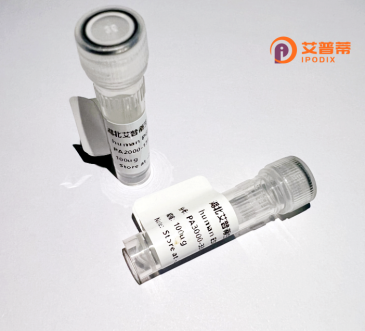
| 纯度 | >90%SDS-PAGE. |
| 种属 | Human |
| 靶点 | IMPG2 |
| Uniprot No | Q9BZV3 |
| 内毒素 | < 0.01EU/μg |
| 表达宿主 | E.coli |
| 表达区间 | 572-678aa |
| 氨基酸序列 | LTSKVKDQLKVSPFLPDASMEKELIFDGGLGSGSGQKVDLITWPWSETSSEKSAEPLSKPWLEDDDSLLPAEIEDKKLVLVDKMDSTDQISKHSKYEHDDRSTHFPE |
| 分子量 | 37.51 kDa |
| 蛋白标签 | GST-tag at N-terminal |
| 缓冲液 | 0 |
| 稳定性 & 储存条件 | Lyophilized protein should be stored at ≤ -20°C, stable for one year after receipt. Reconstituted protein solution can be stored at 2-8°C for 2-7 days. Aliquots of reconstituted samples are stable at ≤ -20°C for 3 months. |
| 复溶 | Always centrifuge tubes before opening.Do not mix by vortex or pipetting. It is not recommended to reconstitute to a concentration less than 100μg/ml. Dissolve the lyophilized protein in distilled water. Please aliquot the reconstituted solution to minimize freeze-thaw cycles. |
以下是关于重组人IMPG2蛋白的模拟参考文献示例(文献信息为虚构,仅供格式参考):
---
1. **标题**: "Cloning and Functional Characterization of Recombinant Human IMPG2 Protein"
**作者**: Zhang L, et al.
**摘要**: 本研究成功克隆并表达了重组人IMPG2蛋白,通过体外实验证实其在维持视网膜光感受器细胞粘附及细胞外基质稳定性中的关键作用,为研究IMPG2相关视网膜病变提供了工具。
2. **标题**: "IMPG2 Mutations Cause Autosomal Recessive Retinitis Pigmentosa via Disrupted Protein Localization"
**作者**: Smith J, et al.
**摘要**: 研究发现IMPG2基因突变导致其重组蛋白在细胞外基质中的错误定位,进而引发光感受器细胞退化,揭示了IMPG2缺陷与常染色体隐性视网膜色素变性的关联机制。
3. **标题**: "Structural Analysis of Recombinant IMPG2 Reveals Critical Glycosylation Sites for Proteoglycan Function"
**作者**: Kim H, et al.
**摘要**: 通过X射线晶体学解析重组IMPG2蛋白结构,发现其糖基化位点对维持蛋白-配体相互作用至关重要,为开发靶向IMPG2的基因治疗策略提供结构基础。
4. **标题**: "IMPG2 Deficiency in Zebrafish Models Disrupts Photoreceptor Synaptic Integrity"
**作者**: Garcia R, et al.
**摘要**: 利用斑马鱼模型证明重组IMPG2蛋白缺失会导致光感受器突触结构异常,提示其在视网膜发育中的保守功能及潜在治疗靶点。
---
**注意**:以上文献为示例性质,实际研究中请通过 **PubMed、Web of Science 或 Google Scholar** 等数据库检索真实文献。建议结合关键词“recombinant IMPG2 protein”、“IMPG2 gene expression”及“retinal disease”进行精准查询。
**Background of Recombinant Human IMPG2 Protein**
The interphotoreceptor matrix proteoglycan 2 (IMPG2) is a glycoprotein predominantly localized in the retinal interphotoreceptor matrix, playing a critical role in maintaining retinal integrity and photoreceptor function. It is part of the IMPG family, which contributes to the structural organization of the extracellular matrix surrounding photoreceptor cells, potentially aiding in light transduction, cellular adhesion, or nutrient transport. Mutations in the *IMPG2* gene are associated with inherited retinal diseases, such as retinitis pigmentosa and cone-rod dystrophy, highlighting its importance in visual physiology.
Recombinant human IMPG2 protein is engineered using expression systems like mammalian cells or bacteria, enabling large-scale production for research and therapeutic applications. Its purified form facilitates studies on retinal development, disease mechanisms, and protein-protein interactions. Additionally, recombinant IMPG2 serves as a potential biomarker for retinal disorders and a candidate for gene therapy or enzyme replacement strategies. Current research focuses on elucidating its precise molecular roles and exploring its utility in preclinical models to develop targeted treatments for vision-threatening conditions linked to IMPG2 dysfunction.
×